Hirnant is a small village and Parish in the Llanfyllin district of the ancient county of Montgomeryshire, some fifteen miles west-south-west of Oswestry and some three miles northeast of Lake Vyrnwy, on the B4396 road between Llanwddyn and Penybontfawr. The men of the village who fell during the Great War are commemorated on the Parish war memorial, which is situated beside the main road, opposite St. Ilog’s Church. The memorial also commemorates thParishioners of the Church who served and returned home.
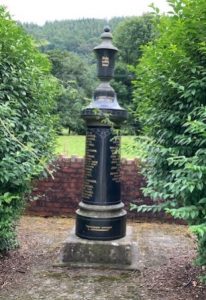
The Great War, 1914-1918
William Jones, Sergeant, 13664, Royal Welsh Fusiliers. William was born at Bethania House, Llanwddyn in 1896, the son of Richard and Sarah Jones. By 1905 the family had moved to 15, Park View, Blaengarw. William enlisted at Bridgend into the 9th Battalion, Royal Welsh Fusiliers soon after the outbreak of war. The battalion had formed at Wrexham in September 1914, before moving to Tidworth to join 58 Brigade, 19th (Western) Division. On 19 July 1915 Evan landed in France with the battalion, and the entire 19th Division then moved to the Nursery Sector at Calonne for trench initiation alongside the Dehra Dun Brigade. The infantry battalions of the division then began carrying out the usual routines of rotating in the trenches: four days in the front line; four in support; and four in reserve, interspersed with training regimes and carrying out working parties and trench raids. Just south, the British launched a great offensive around the town of Loos on 25 September 1915, and the 19th Division was ordered to attack from its positions at the same time, to attempt to draw enemy attention away from the main battle area. The attacking battalions of the 19th Division were in place by 04.00, and then at 05.50 the men climbed out of their trenches to launch their assault, behind a gas and smoke screen. The assault was a disaster, and heavy casualties were suffered by the 19th Division for no gain. At the end of April 1916, after six trying months in the Flanders trenches, the Division moved into reserve, and its battalions began a training scheme, prior to moving south into the Somme sector. By 28 June the 9th RWF had moved into billets at Bresle, and on the night of 30 June moved forward to assembly positions south of the Amiens to Albert road. On the following morning, 1 July 1916, the Battle of the Somme opened, and the 19th Division moved into support along the Albert to Bapaume road to trenches on the Tara to Usna Line. The 34th Division had attacked La Boiselle that morning, and its advance had been stopped by German machine-gun fire, so 58 Brigade was ordered forwards to carry on the offensive, launching its assault on 2 July. Suffering heavy losses, the Brigade dug in as darkness fell, and on the following morning, 3 July 1916, resumed the assault. William was killed in action during the renewed assault that day. The 20-year-old has no known grave and is commemorated on the Thiepval Memorial, France.
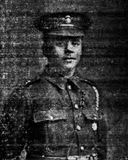
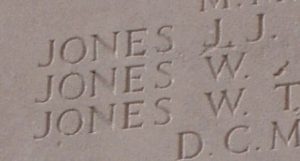
William Richard Lloyd, Able Seaman, R/4333, Royal Naval Volunteer Reserve. William was born on 6 March 1886, the son of Thomas and Mary Lloyd, of Ty Isa, Hirnant. He enlisted into the Royal Welsh Fusiliers on 12 December 1915 and was initially placed on the Army Reserve. On 28 June 1917 he was mobilised and posted to the Royal Naval Volunteer Reserve, then on 30 October 1917 was posted to France, joining Anson Battalion, Royal Naval Reserve, which was attached to the 63rd (Royal Naval) Division. The Division had been formed at the outbreak of war, due to there being more sailors than ships, so the Division was formed to utilise the surplus of Royal Naval sailors as infantry. The Division had suffered heavy casualties during an assault on Passchendaele Ridge on 26 October, in an assault which saw Anson battalion alone suffer 260 casualties. After rebuilding, Anson Battalion went back into the line on the ridge on 5 November for its last tour at Ypres, before the Division was relieved and by 13 November had moved to Arneke, before transferring south, reaching Beaulencourt by 11 December to join the fighting at Cambrai. William came home on sick leave for a short period, and married a widow, Sarah Williams, of 4, Derby Road, High Town, Wrexham, before returning to France. In the meantime, the Allies had launched a huge assault towards Cambrai on 20 November, utilising massed tank formations and had broken the Hindenburg Line, however, the Germans counter-attacked on 30 November and regained all of the ground lost so with the situation desperate, the Royal Naval Division was thrown into action, stopping the Germans after an epic fight on Welsh Ridge on 30 December 1917. The Division remained in the Cambrai sector over the winter, holding the line near Havrincourt Wood, and on 21 March 1918 was hit hard by the Germans when they launched their desperate Spring Offensive. The Royal Naval Division was forced to withdraw towards Thiepval over the coming days, fighting a desperate rearguard action. William was wounded in the leg and taken by prisoner on 24 March 1918 and was taken to a German Military Hospital based in a former girls school in Mons. He died there on 18 April 1918, as a result of cardiac weakness which had been exacerbated by his wounds. The 32-year-old was buried in Mons (Bergen) Communal Cemetery, Belgium. William does not appear to be commemorated locally. His sister, Elizabeth Eleanor Lloyd, lost her husband, Robert Ellis, in France in 1914.
Reverend Edward Rupert Menlow Jenkins Menlove, Rifleman, R/23951, King’s Royal Rifle Corps. Edward was born at St. Martin’s, Oswestry in 1884, the son of Reverend John Jenkins Menlove and Mrs Lucy Mary Jenkins Menlove. His father was from Borth, and was vicar of St. Martin’s, before taking over the position at Hirnant prior to 1891. Edward was educated at Ellesmere and Oxford prior to becoming curate of Rhosllanarchrugog. He then became curate of Bodelwyddan, and lived at Tycelyn prior to the war. He enlisted into the King’s Royal Rifle Corps and was posted to France in 1916, joining the 2nd Battalion, King’s Royal Rifle Corps, which was attached to 2 Brigade, 1st Division. The division had been in the South Maroc Sector at Loos, but at the beginning of July 1916 was relieved and began moving south to the Somme, in order to join the Somme offensive. By 10 July the 2nd KRRC had reached Dernancourt and during the afternoon moved forwards to Becourt, southeast of Albert. On the morning of 15 July the Division received orders to proceed via the recently captured Mametz Wood to the new front line, facing Bazentin Ridge, and took over positions near Bazentin-le-Petit Wood. On the following morning 3 Brigade of the Division took part in its first assault on the Somme, but came under intense machine-gun fire, before being relieved by 2 Brigade on 19 July, after a torrid spell in the line. The 2nd KRRC then moved into the front line and continued with the attacks on High Wood over the coming days before being relieved on 23 July and moving back to Albert before moving out of the battle area to refit and train. By 15 August the 2nd KRRC had moved back into the battle area and was bivouacked in Mametz Wood and on 20 August took part in severe fighting following a German counter-attack. The battalion remained in the area over the coming weeks, rotating in the front line and in support positions. On 9 September 1916 the 2nd KRRC took part in another assault, to the south of Pozieres. Edward was killed in action during the assault that day. The 31-year-old has no known grave and is commemorated on the Thiepval Memorial, France.
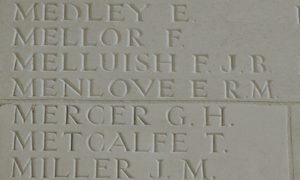
Ellis Humphrey Morris, Private, 31360, South Wales Borderers. Ellis was the son of John and Hannah Morris, of Bwlch Sych, Hirnant. He worked as a farm servant prior to the war. Ellis enlisted at Wrexham into the King’s Shropshire Light Infantry, but was then posted to the 3rd Battalion, South Wales Borderers, which was at Hightown, Liverpool, as part of the Mersey Garrison. As well as being used as garrison troops, the battalion’s main role was to train and supply troops for the two front line regular battalions, the 1st and 2nd South Wales Borderers, which were both on the Western Front. Ellis never got to serve overseas, as he took ill whilst serving in Liverpool, and died of cerebro-spinal meningitis in hospital there on 6 September 1917. The remains of the 25-year-old were brought home and he was buried two days later in St. Illog’s Churchyard, Hirnant. His brother, Thomas, was killed in France in 1917, whilst an elder brother, Robert, died in 1922 of disease contracted during the war.
Robert Humphrey Morris, Private, 69354, Cheshire Regiment. Robert was the son of John Morris and Hannah Morris (nee Humphreys), of Bwlch Sych, Hirnant. He worked as an agricultural labourer at Gelli Ganol, Hirnant prior to the war. Robert married Mary Jones at Llangynog on 13 June 1910 and the couple set up home at Gelli Canol. He enlisted into the King’s Shropshire Light Infantry, and had served in France with the 1st Battalion, King’s Shropshire Light Infantry at some time during the war. He was later posted to the Cheshire Regiment. Robert returned home safely after the war, but his service had taken its toll on his health and he died of disease at Hirnant on 12 December 1922. The 36-year-old was buried three days later in St. Silin’s Churchyard, Llansilin. Robert is not commemorated as a war casualty by the CWGC and he is not commemorated on the Hirnant war memorial. His brothers, Thomas and Ellis Morris had both died on active service in 1917.
Thomas Morris, Private, 54484, Royal Welsh Fusiliers. Thomas was the of John and Hannah Morris, of Bwlch Sych, Hirnant. He worked as a farm labourer at Penybontfawr prior to the war. Thomas enlisted into the Welsh Horse Yeomanry at Newtown soon after the outbreak of war. The battalion had formed in South Wales, but moved to Newtown before moving to the Diss area in Norfolk, joining the 1/1st North Midland Mounted Brigade, 1st Mounted Division. The Welsh Horse embarked at Liverpool aboard the SS Olympic on 25 September 1915 and landed at Anzac Cove, Gallipoli. Thomas did not embark for Gallipoli, but was instead transferred to the Royal Welsh Fusiliers, and during the winter of 1916-17 was posted to France, joining the 15th Battalion, Royal Welsh Fusiliers, which was attached to 113 Brigade, 38th (Welsh) Division. The Division had taken over the Canal Bank sector at Boesinghe, north of Ypres, in September 1916 following its epic assault on Mametz Wood in July. The infantry battalions of the Division then began carrying out the normal pattern of rotation in the trenches, four days in the front, four in support and four in reserve, whilst also working on trench improvement, digging new trenches, and also carrying out regular patrols and trench raids. During the first week of April 1917 the 15th RWF found itself holding the front line, during a routine tour in the trenches. The battalion was relieved by the 14th RWF on 4 April, and moved into the support line on the Canal Bank, where it would stay for the coming days. On the night of 9 April things began to heat up, when a German party was spotted in No Mans Land and fired upon, bringing about a retaliatory barrage of trench mortar shells and rifle grenades. Thomas was one of three men killed by a rifle grenade on the following morning, 10 April 1917. The 26-year-old is buried with his comrades in Essex Farm Cemetery, Belgium. His brother, Ellis Humphrey Morris, also died on active service in 1917, whilst an elder brother, Robert, died in 1922 of disease contracted during the war.
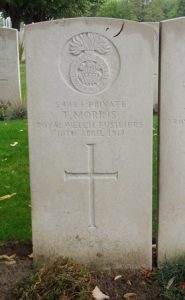
Edward Thomas, Gunner, 213712, Royal Field Artillery. Edward was the son of John and Sarah Thomas, of Cwmmur Ucha, Penybontfawr. He worked at Tyfos Farm, Llandrillo prior to enlisting at Dolgellau into the Royal Field Artillery in March 1917. After completing his training, Edward embarked for France, to join B Battery, 187th Brigade, Royal Field Artillery. The battery was attached to the 41st Division and, following heavy fighting during the Third Battle of Ypres, was selected as one of five British Divisions to be moved to Italy, as part of a reinforcement action taken by the Allies following a disastrous defeat of the Italian Army at Caporetto. The Division arrived at Mantua on 17 November 1917, where it held a part of the line on the River Piave, however, the crisis had passed, and the Division was hurried back to the Western Front in early March 1918. The Division then moved to Flanders where it held the St. Eloi sector near Ypres that was, for once, relatively quiet. Edward was killed whilst his battery was carrying out operations at St. Eloi on 5 April 1918. The 29-year-old has no known grave and is commemorated on the Tyne Cot Memorial, Belgium.
RHAI HUN A FU FARW Y BYDDYM NI BYD
HEFYD A GLWFWYD
Evan Thomas. Cwmmur Ucha.
Allen Jones. Ty Isa
Thomas J. Edwards. Bryntirion
Robert Jenkins. Clochnant Bach
Henry J. Hughes, Watkin Morris. Pengeuffordd
NEW Y RHAI A YMYNODDAR FYDDIN
David Evans. Tycroes
William Jenkins, Clochnant Bach
David Morris, Evan T Hughes. Pengeuffordd
Owen I. Lloyd. Bache
John E. Evans. Fron
Robert Morris. Bwlchsych
John Evans. Tyntwll